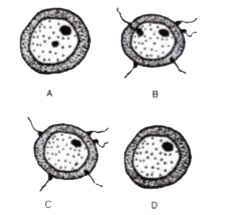Is the chromosome number of zygote, embryonal cells and adult of a particular organism always constant? How is the constancy maintained in these three stages?
Step-by-Step Solution:
1. Understanding the Chromosome Number:
- The chromosome number refers to the total number of chromosomes present in a cell. In sexually reproducing organisms, this number is constant for a species and is typically represented as 2n (diploid), which means two sets of chromosomes.
2. Formation of the Zygote:
- A zygote is formed when a sperm cell fertilizes an egg cell. This fertilization restores the diploid chromosome number, which is characteristic of that particular organism.
3. Mitosis in Development:
- After the zygote is formed, it undergoes a process called mitosis. Mitosis is a type of cell division that results in two daughter cells, each having the same number of chromosomes as the original cell (the zygote).
4. Chromosome Constancy in Embryonal Cells:
- As the zygote divides through mitosis, all the resulting embryonal cells will also have the same chromosome number as the zygote. This means that the chromosome number remains constant during the early stages of development.
5. Development into Adult Organism:
- As the embryo continues to develop into a fetus and eventually into an adult organism, the cells continue to divide by mitosis. Therefore, the chromosome number remains the same throughout these stages.
6. Conclusion:
- In summary, the chromosome number of the zygote, embryonal cells, and the adult organism is always constant. This constancy is maintained through the process of mitosis, where the number of chromosomes in the daughter cells remains the same as that in the parent cell.
- The chromosome number refers to the total number of chromosomes present in a cell. In sexually reproducing organisms, this number is constant for a species and is typically represented as 2n (diploid), which means two sets of chromosomes.
- A zygote is formed when a sperm cell fertilizes an egg cell. This fertilization restores the diploid chromosome number, which is characteristic of that particular organism.
- After the zygote is formed, it undergoes a process called mitosis. Mitosis is a type of cell division that results in two daughter cells, each having the same number of chromosomes as the original cell (the zygote).
- As the zygote divides through mitosis, all the resulting embryonal cells will also have the same chromosome number as the zygote. This means that the chromosome number remains constant during the early stages of development.
- As the embryo continues to develop into a fetus and eventually into an adult organism, the cells continue to divide by mitosis. Therefore, the chromosome number remains the same throughout these stages.
- In summary, the chromosome number of the zygote, embryonal cells, and the adult organism is always constant. This constancy is maintained through the process of mitosis, where the number of chromosomes in the daughter cells remains the same as that in the parent cell.
Topper's Solved these Questions
- BOOK - NCERT EXEMPLAR ENGLISHCHAPTER - HOW DO ORGANISMS REPRODUCEEXERCISE - Long Answer Type Questions10videos
HOW DO ORGANISMS REPRODUCE
- BOOK - NCERT EXEMPLAR ENGLISHCHAPTER - HOW DO ORGANISMS REPRODUCEEXERCISE - Long Answer Type Questions10videos
HOW DO ORGANISMS REPRODUCE
- BOOK - NCERT EXEMPLAR ENGLISHCHAPTER - HEREDITY AND EVOLUTION EXERCISE - LONG ANSWER TYPE QUESTIONS11videos
HEREDITY AND EVOLUTION
- BOOK - NCERT EXEMPLAR ENGLISHCHAPTER - LIFE PROCESSESEXERCISE - Long Answer Type Questions11videos
LIFE PROCESSES
Similar Questions
The number of chromosomes in parents and offsprings of a particular species remains constant. due to
View SolutionThe number and kinds of organism is not constant. How do you explain this statement?
View SolutionHow is the chromosome number maintained in sexually reproducing organisms?
View SolutionFrom the internet, gather information about the chromosome numbers of five animals and five plants. Correlate the number with the size of organism and answer the following questions.
(a) Do larger organisms have more number of chromosomes/cells?
(b) Can organism with fewer chromosomes reproduce more easil than orgamsms with more number of chromosomes?
(c) More the number of chromosomes/cells greater is the DNA content. Justify.View SolutionThe number of ways of distributing 12 different objects among three person such that one particular person is always getting 6 objects and the remaining two persons are getting three objects each is
View SolutionGiven below are diagrams showing the different stages in the process of fertilisation of an egg in the human female reproductive tract.
Study the diagrams and answer the questions

(i) Arrange the letters given below each diagram in a logical sequence to show the correct order in the process of fertilisation.
(ii) Where does fertilisation normally take place? What is 'Implantation' that follows fertilisation ?
(iii) Mention the chromosome number of the egg and zygote in humans.
(iv) Explain the term 'Gestation'. How long does Gestation last in humans ?
(v) Draw a neat, labelled diagram of a mature human sperm.View SolutionHow do gametogenesis and fertilisation playan important role in maintaining constancy in chromosome number during sexual reproduction?
View SolutionA teacher was trying to show the different stages of a type of cell division to the students. At a particular stage , it was observed that the chromosomes were separating but there was no splitting of centromeres. This stage would be
View SolutionWhat would be the ratio of chromosome number between an egg and its zygote? How is the sperm genetically different from the egg?
View SolutionA group of students at Omega high school is using staples and popsicle sticks to build a scale model of the Great wall of china as part of a Project detailing China's military history. The number of staples the students will need is three times the number of popsicle sticks they will need. If the students determine they need 84 staples for this particular project, how many popsicle sticks will they need?
View Solution

